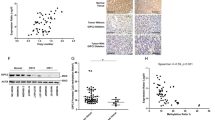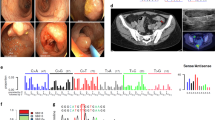Abstract
Ferric nitrilotriacetate induces oxidative damage in renal proximal tubules, a consequence of Fenton-like reaction, that ultimately leads to a high incidence of renal cell carcinoma (RCC) in rats. In order to find common genetic alterations in this oxystress-induced carcinogenesis model, RCCs were produced in F1 hybrid rats between Wistar and Long-Evans strains and genomes were screened for loss of heterozygosity (LOH) with microsatellite polymorphic markers by PCR. Five consecutive markers on chromosome 5 (D5Mgh5, D5Mit9, D5Mgh6, D5Mit11 and D5Mit6) showed LOH in ≥40% of the RCCs. As possible candidate tumor suppressor genes on chromosome 5, p15INK4B and p16INK4A were investigated for genetic alteration and aberrant methylation by Southern blot, PCR/SSCP/sequencing and methylation-specific PCR. Genetic alteration (homozygous or hemizygous deletion with or without point mutation) or aberrant methylation were found in 30.7 and 53.8% of the RCC cases, respectively, which was proportionally associated with the histological nuclear grade and metastatic activity. Our data suggest that inactivation of p15 and p16 genes could be one of the major pathways responsible for oxystress-induced carcinogenesis.
This is a preview of subscription content, access via your institution
Access options
Subscribe to this journal
Receive 50 print issues and online access
$259.00 per year
only $5.18 per issue
Buy this article
- Purchase on Springer Link
- Instant access to full article PDF
Prices may be subject to local taxes which are calculated during checkout




Similar content being viewed by others
Abbreviations
- Fe-NTA:
-
ferric nitrilotriacetate
- HNE:
-
4-hydroxy-2-nonenal
- LOH:
-
loss of heterozygosity
- MDA:
-
malondialdehyde
- PCR:
-
polymerase chain reaction
- RCC:
-
renal cell carcinoma
- ROS:
-
reactive oxygen species
- SSCP:
-
single-strand conformation polymorphism
References
Cairns P, Polascik TJ, Eby Y, Tokino K, Califano J, Merlo A, Mao L, Herath J, Jenkins R, Westra W, Rutter JL, Buckler A, Gabrielson E, Tockman M, Cho KR, Hedrick L, Bova GS, Isaacs W, Koch W, Schwab D and Sidransky D. . 1995a Nat. Genet. 11: 210–212.
Cairns P, Tokino K, Eby Y and Sidransky D. . 1995b Cancer Res. 55: 224–227.
Ebina Y, Okada S, Hamazaki S, Ogino F, Li J-L and Midorikawa O. . 1986 J. Natl. Cancer Inst. 76: 107–113.
Halliwell B and Aruoma OI. . 1993 In: DNA and free radicals Ellis Horwood Ltd., Chichester, England.
Herman JG, Graff JR, Myohanen S, Nelkin BD and Baylin SB. . 1996a Proc. Natl. Acad. Sci. USA 93: 9821–9826.
Herman JG, Jen J, Merlo A and Baylin SB. . 1996b Cancer Res. 56: 722–727.
Hino O, Mitani H, Katsuyama H and Kubo Y. . 1994 Cancer Lett. 83: 117–121.
Hino O, Kobayashi E, Hirayama Y, Kobayashi T, Kubo Y, Tsuchiya H, Kikuchi Y and Mitani H. . 1995 Mol. Carcinog. 14: 23–27.
Knapek DF, Serrano M, Beach D, Trono D and Walker CL. . 1995 Cancer Res. 55: 1607–1612.
Knudson Jr AG, Hethcote HW and Brown BW. . 1975 Proc. Natl. Acad. Sci. USA 72: 5116–5120.
McBride TJ, Preston BD and Loeb LA. . 1991 Biochemistry 30: 207–213.
Nishiyama Y, Suwa H, Okamoto K, Fukumoto M, Hiai H and Toyokuni S. . 1995 Jpn. J. Cancer Res. 86: 1150–1158.
Osaka M, Matsuo S, Koh T, Liang P, Kinoshita H, Maeda S and Sugiyama T. . 1995 Cancer Lett. 91: 25–31.
Schwerdtle RF, Störkel S, Neuhaus C, Brauch H, Weidt E, Brenner W, Hohenfellner R, Huber C and Decker H-J. . 1996 Cancer Res. 56: 2927–2930.
Swafford DS, Middleton SK, Palmisano WA, Nikula KJ, Tesfaigzi J, Baylin SB, Herman JG and Belinsky SA. . 1997 Mol. Cell. Biol. 17: 1366–1374.
Toyokuni S and Sagripanti J-L. . 1993 Carcinogenesis 14: 223–227.
Toyokuni S, Mori T and Dizdaroglu M. . 1994a Int. J. Cancer 57: 123–128.
Toyokuni S, Uchida K, Okamoto K, Hattori-Nakakuki Y, Hiai H and Stadtman ER. . 1994b Proc. Natl. Acad. Sci. USA 91: 2616–2620.
Toyokuni S. . 1996 Free Radic. Biol. Med. 20: 553–566.
Toyokuni S, Okada K, Kondo S, Nishioka H, Tanaka T, Nishiyama Y, Hino O and Hiai H. . 1998 Jpn. J. Cancer Res. 89: 814–820.
Toyokuni S. . 1999 Pathol. Int. 49: 91–102.
Acknowledgements
This study was supported in part by a Grant-in-Aid from the Japanese Ministry of Education, Science, Sports and Culture, a grant from the Program for Promotion of Basic Research Activities for Innovative Bioscience (PROBRAIN), and a grant from the Japanese Owner's Association. We thank Ms Noriko Shibata for technical assistance and James E Strickland (NCI, NIH, Bethesda, MD, USA) for critical reading of the manuscript.
Author information
Authors and Affiliations
Rights and permissions
About this article
Cite this article
Tanaka, T., Iwasa, Y., Kondo, S. et al. High incidence of allelic loss on chromosome 5 and inactivation of p15INK4B and p16INK4A tumor suppressor genes in oxystress-induced renal cell carcinoma of rats. Oncogene 18, 3793–3797 (1999). https://doi.org/10.1038/sj.onc.1202707
Received:
Revised:
Accepted:
Published:
Issue Date:
DOI: https://doi.org/10.1038/sj.onc.1202707
Keywords
This article is cited by
-
Environmental impact on carcinogenesis under BRCA1 haploinsufficiency
Genes and Environment (2023)
-
Epigenetics in renal cell cancer: mechanisms and clinical applications
Nature Reviews Urology (2018)
-
Identification of Nitration Sites by Peroxynitrite on p16 Protein
The Protein Journal (2012)
-
p16Ink4a overexpression in cancer: a tumor suppressor gene associated with senescence and high-grade tumors
Oncogene (2011)
-
Homozygous deletion of CDKN2A/2B is a hallmark of iron-induced high-grade rat mesothelioma
Laboratory Investigation (2010)



